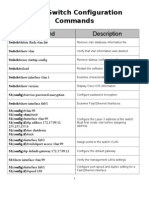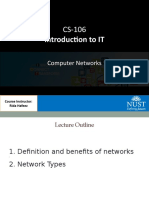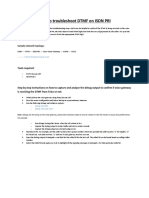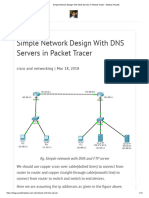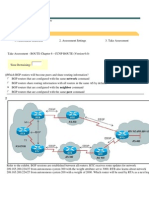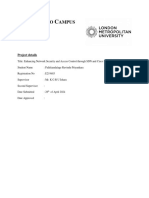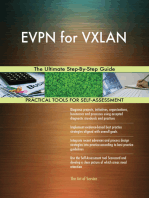0 ratings0% found this document useful (0 votes)
144 viewsCcna Subnetting
Ccna Subnetting
Uploaded by
SrimannarayanaJamiliSubnet masks define the boundaries between the network and host portions of an IP address. They are used to determine which devices can communicate on a local network versus across network boundaries. There are different subnet mask structures for class A, B, and C IP addresses. The network address is the starting IP that defines a network boundary, while the broadcast address is the ending IP - all devices with IPs between these can communicate locally. Subnetting is used to logically break a major network into smaller subnets to reduce IP address waste. It involves increasing the network bits in the subnet mask to create more networks with fewer available hosts per network. Variable length subnet masking (VLSM) allows different subnet masks within the same network, enabling even more efficient use
Copyright:
© All Rights Reserved
Available Formats
Download as RTF, PDF, TXT or read online from Scribd
Ccna Subnetting
Ccna Subnetting
Uploaded by
SrimannarayanaJamili0 ratings0% found this document useful (0 votes)
144 views6 pagesSubnet masks define the boundaries between the network and host portions of an IP address. They are used to determine which devices can communicate on a local network versus across network boundaries. There are different subnet mask structures for class A, B, and C IP addresses. The network address is the starting IP that defines a network boundary, while the broadcast address is the ending IP - all devices with IPs between these can communicate locally. Subnetting is used to logically break a major network into smaller subnets to reduce IP address waste. It involves increasing the network bits in the subnet mask to create more networks with fewer available hosts per network. Variable length subnet masking (VLSM) allows different subnet masks within the same network, enabling even more efficient use
Original Description:
how to subnetting
in class a b and c
Original Title
ccna-subnetting
Copyright
© © All Rights Reserved
Available Formats
RTF, PDF, TXT or read online from Scribd
Share this document
Did you find this document useful?
Is this content inappropriate?
Subnet masks define the boundaries between the network and host portions of an IP address. They are used to determine which devices can communicate on a local network versus across network boundaries. There are different subnet mask structures for class A, B, and C IP addresses. The network address is the starting IP that defines a network boundary, while the broadcast address is the ending IP - all devices with IPs between these can communicate locally. Subnetting is used to logically break a major network into smaller subnets to reduce IP address waste. It involves increasing the network bits in the subnet mask to create more networks with fewer available hosts per network. Variable length subnet masking (VLSM) allows different subnet masks within the same network, enabling even more efficient use
Copyright:
© All Rights Reserved
Available Formats
Download as RTF, PDF, TXT or read online from Scribd
Download as rtf, pdf, or txt
0 ratings0% found this document useful (0 votes)
144 views6 pagesCcna Subnetting
Ccna Subnetting
Uploaded by
SrimannarayanaJamiliSubnet masks define the boundaries between the network and host portions of an IP address. They are used to determine which devices can communicate on a local network versus across network boundaries. There are different subnet mask structures for class A, B, and C IP addresses. The network address is the starting IP that defines a network boundary, while the broadcast address is the ending IP - all devices with IPs between these can communicate locally. Subnetting is used to logically break a major network into smaller subnets to reduce IP address waste. It involves increasing the network bits in the subnet mask to create more networks with fewer available hosts per network. Variable length subnet masking (VLSM) allows different subnet masks within the same network, enabling even more efficient use
Copyright:
© All Rights Reserved
Available Formats
Download as RTF, PDF, TXT or read online from Scribd
Download as rtf, pdf, or txt
You are on page 1of 6
Subnet Mask Value:
Subnet mask value defines properties of IP Address to which it
can communicate and to which it can not
Subnet mask value defines Network component and host
component of an IP address
Ip address uses subnet mask to find out boundaries of network
Subnet mask value is a driver of IP address
Network Bits are always represented with
!ost bits are always represented with "
Subnet Mask Structure:
#lass A Subnet Mast structure
N$!$!$!
$""""""""$""""""""$""""""""
%&&$"$"$"
#lass B Subnet Mask Structure
N$N$!$!
$$""""""""$""""""""
#lass # Subnet Mast Structure
N$N$N$!
$$$""""""""
%&&$%&&$%&&$"
'hat is Network Address
Network Address is the identification address for all the systems in the
network
(he systems with same network address can communicate with each
other
Systems with different network addresses can not communicate
)enerally
'hat is Broadcast Address
Broadcast Address is used to deliver a broadcast messa)e to all the
computers in the network
(he systems with same network address can have same broadcast
address
All the systems in between Network address and broadcast address
form a lo)ical network to communicate with each other$
note:Network Address and Broad cast Address are the boundaries of a
network$ (hey can*t be assi)ned to computers
!ow to find out Network Address
Identify class of IP address and Subnet mask Structure$
+eplace host portion with *"*,or-
Perform a lo)ical AN. operation between IP Address and subnet mask
value
!ow to find out Broadcast Address
Identify class of Ip Address and Subnet mask Structure
+eplace !ost portion with %&&
perform a lo)ical /+ operation between IP Address and inverse
Subnetmask value
01:
"$2&$%%3$4
N$!$!$!
Network Address5"$"$"$"
Broadcast Address5"$%&&$%&&$%&&
6%$%&$4$78
N$N$!$!
Network address56%$%&$"$"
Broadcast Address56%$%&$%&&$%&&
4%$82$""$""
N$N$N$!
Network Address54%$82$""$"
Broadcast Address54%$82$""$%&&
IP address +elated /r)ani9ations:
IANA:internet Assi)ned Numbers Authority
I#ANN:Internet #orporation for Assi)ned Numbers and names
Private IP Address:
(he IP addresses not routable in public network
;sed to communicate within private network
Internet access is not possible with private ip address
.efined in +<# 42
#lassA "$"$"$":"$%&&$%&&$%&&
#lass B 6%$8$"$":6%$3$%&&$%&&
#lass # 4%$82$"$":4%$82$%&&$%&&
Special IP addresses:
Network is reserved for default routin)$ #annot assi)ned to systems
%6$"$"$" Network is reserved for loop back purpose ,NI# dia)nosis-
#lass . Networks are reserved for multicastin)$ Not for systems
#lass 0 Networks are reserved for +esearch and .evelopment$ Not for
systems
Subnettin)
'hat is subnettin)=
>o)ically breakin) the ma?or network into smaller networks:subnets
Advanta)e of subnettin)
+educe wasta)e of ip address
Subnettin) Procedure:
Increase network bits in the subnet mask value from left to ri)ht
Subnettin) formulae:
No$ of networks 5 %pwer n
N5increased network bits
No$ of !osts per network 5,% power !-:%
!5remainin) host bits
Subnettin) Methods:
Subnettin) can be done in two ways
Based on No$of Networks
Based on No$ of !osts
Subnettin) #alculations:
Based on No$ of Networks:
Identify re@uired No$ of subnets
+efer % power chart
Identify N value
Increast the bits in the subnetmask value
Identify ! value
<ind out new subnet mask value
<ind out No$ of subnets and No$ of hosts
Subtract new subnet mask value from %&&$%&&$%&&$%&&
<ind out network address and Broadcast address of all
subnets
Based on No$ of hosts:
o Identify re@uired No$ of hosts per subnet
o +efer % power hart
o Identify ! value
o Increase the bits in the subnetmask value
o Identify N value
o <ind out new subnet mask value
o <ind out No$of subnets and No$of hosts
o Subtract new subnet mask value form %&&$%&&$%&&$%&&
o <ind out network address and Broadcast address of all subnets
01ercise:
.ivide 4%$82$""$" into 7 subnets
.ivide "$"$"$" into " subnets
.ivide 6%$8$"$"$ into 8 subnets
.ivide 4%$82$""$" into subnets with %2 hosts
.ivide "$"$"$" into subnets with 7""" hosts
.ivide 6%$8$"$" into subnets &"" hosts
V>SM
'hat is vlsm
Variable length subnet Mask
Also called as subnetting of subnetting
Subnetting is used to break the network equally
If these networks are subneetted again, different subnets may have different
subnet mask values, also called as Variable length subnet masks
With vlsm, IP addressing scheme is used more efficiently without wastage
Subnetting and VSM com!arisions
Subnetting VSM
"reaking netwok equally "reaking network unequally
Sub#netting Subnetting of subnetting
$as same subnet mask value $as different subnet mask values
%educe IP wastage %educe IP wastage more effectively
&esign IP address scheme for the network with '()*'+,*'*-
"ranch' '-' hosts
"ranch ) )+ hosts
"ranch . ),hosts
"ranch'#) wan link ) hosts
"ranch )#. wan link ) hosts
"ranch .#' wan link ) hosts
You might also like
- UPS STATIC, 33655031_Spec_2022-02_A00Document54 pagesUPS STATIC, 33655031_Spec_2022-02_A00salem elhajNo ratings yet
- 3.1.2.12 Lab - Building A Switched Network With Redundant LinksDocument9 pages3.1.2.12 Lab - Building A Switched Network With Redundant LinksRamiro CollaguazoNo ratings yet
- Lab - Calculate Ipv4 Subnets: ObjectivesDocument4 pagesLab - Calculate Ipv4 Subnets: ObjectivesJad Abou ZeidNo ratings yet
- CCNA Cheat Sheet IPv6Document4 pagesCCNA Cheat Sheet IPv6Thomas SchmelingNo ratings yet
- Packet Tracer ScriptsDocument53 pagesPacket Tracer ScriptsLammetje Lives33% (3)
- IT Operations Management Team A Complete Guide - 2021 EditionFrom EverandIT Operations Management Team A Complete Guide - 2021 EditionNo ratings yet
- Bus Shelter RFP RevisedDocument13 pagesBus Shelter RFP RevisedMuhammad Hasif0% (1)
- 10.2.1.9 Lab - Configure A Site-to-Site IPsec VPN Using ISR CLI and ASA 5505 ASDMDocument22 pages10.2.1.9 Lab - Configure A Site-to-Site IPsec VPN Using ISR CLI and ASA 5505 ASDMelizaNo ratings yet
- VPNDocument44 pagesVPNShahzaib RaufNo ratings yet
- Mode Prompt Command To Enter Command To ExitDocument8 pagesMode Prompt Command To Enter Command To ExitManjunathNo ratings yet
- Easy Sub Netting FullDocument63 pagesEasy Sub Netting Fullharikrishna500100% (2)
- 9.4.1.7 Lab - Configuring ASA 5510 Basic Settings and Firewall Using ASDM - InstructorDocument56 pages9.4.1.7 Lab - Configuring ASA 5510 Basic Settings and Firewall Using ASDM - InstructorSalem TrabelsiNo ratings yet
- Ccna (Router Configurations)Document159 pagesCcna (Router Configurations)Sudhir MaherwalNo ratings yet
- Lab6 - 2 CiscoDocument8 pagesLab6 - 2 CiscoMoussa MarNo ratings yet
- Optiplex 3000 Thinclient Technical GuidebookDocument27 pagesOptiplex 3000 Thinclient Technical GuidebookAndre Rodrigues afonsoNo ratings yet
- Computer Network Lab - 1 (Cisco Packet Tracer) 1. Build A Peer To Peer Network Between Two PcsDocument11 pagesComputer Network Lab - 1 (Cisco Packet Tracer) 1. Build A Peer To Peer Network Between Two PcsmunshinawNo ratings yet
- Topology (Network Design) : White White White White White White White WhiteDocument43 pagesTopology (Network Design) : White White White White White White White WhiteMohsin AhmadNo ratings yet
- Mikrotik Enterprise Wireless Networks and CapsmanDocument51 pagesMikrotik Enterprise Wireless Networks and CapsmanNikos KolosNo ratings yet
- Basic Switch Configuration CommandsDocument7 pagesBasic Switch Configuration CommandsmeachamrobNo ratings yet
- 12 Computer NetworksDocument72 pages12 Computer NetworksAbdullah ShahzadNo ratings yet
- 10.1.4.8 Lab A - DONEDocument40 pages10.1.4.8 Lab A - DONEDakotaNo ratings yet
- Socket Programming - Client and Server PDFDocument3 pagesSocket Programming - Client and Server PDF一鸿No ratings yet
- Introduction To NAT and PATDocument5 pagesIntroduction To NAT and PATThọ Lương ĐìnhNo ratings yet
- Cisco IOS Security Command Reference - Commands D To L Cisco IOS XEDocument160 pagesCisco IOS Security Command Reference - Commands D To L Cisco IOS XEsilverclericNo ratings yet
- Fundamentals of Wireless LANs Answer - 100%Document8 pagesFundamentals of Wireless LANs Answer - 100%John van der VaartNo ratings yet
- NetworksDocument31 pagesNetworksKritikaNo ratings yet
- CCNA Security Chapter 2 Exam v2 - CCNA Exam 2016Document8 pagesCCNA Security Chapter 2 Exam v2 - CCNA Exam 2016Asa mathewNo ratings yet
- Intrusion Detection, Firewalls, and Intrusion PreventionDocument52 pagesIntrusion Detection, Firewalls, and Intrusion PreventionkhandeshaNo ratings yet
- Fundamentals of Wireless LANs AnswerDocument74 pagesFundamentals of Wireless LANs Answermario1349No ratings yet
- CCNA2 Case Study 2022Document6 pagesCCNA2 Case Study 2022Mohammed El-Saadi100% (1)
- How To Troubleshoot DTMF On ISDN PRIDocument11 pagesHow To Troubleshoot DTMF On ISDN PRIaskerder wangNo ratings yet
- Mtcna PDFDocument683 pagesMtcna PDFAnisa Nur KhovivahNo ratings yet
- Subnet Cheat SheetDocument3 pagesSubnet Cheat Sheetsaed218No ratings yet
- 8.1.4.8 Lab - Designing and Implementing A Subnetted IPv4 Addressing SchemeDocument7 pages8.1.4.8 Lab - Designing and Implementing A Subnetted IPv4 Addressing SchemeRYanNo ratings yet
- Remote ExploitationDocument2 pagesRemote Exploitationapi-22231386No ratings yet
- 10.2.3.4 Lab - Troubleshooting Advanced Single-Area OSPFv2Document7 pages10.2.3.4 Lab - Troubleshooting Advanced Single-Area OSPFv2Dario ChNo ratings yet
- 4.4.1.2 Lab - Configuring Zone-Based Policy FirewallsDocument15 pages4.4.1.2 Lab - Configuring Zone-Based Policy FirewallselizaNo ratings yet
- Variable Length Subnetting: Jim Blanco Aparicio-Levy Technical CenterDocument14 pagesVariable Length Subnetting: Jim Blanco Aparicio-Levy Technical Centerhussien amareNo ratings yet
- How To Capture and Use WireShark Trace Data With EtherCAT ApplicationsDocument9 pagesHow To Capture and Use WireShark Trace Data With EtherCAT Applicationstomociy172No ratings yet
- Asterisk NowDocument82 pagesAsterisk Nowkambojk100% (1)
- CCNPDocument2 pagesCCNPBalajie NNo ratings yet
- Chapter 4. Using The Command-Line InterfaceDocument22 pagesChapter 4. Using The Command-Line InterfacePoojitha NagarajaNo ratings yet
- 11.2.4.8 Lab - Securing Network DevicesDocument8 pages11.2.4.8 Lab - Securing Network DevicesParthPatel60% (5)
- Simple Network Design With DNS Servers in Packet Tracer - Madhav PaudelDocument12 pagesSimple Network Design With DNS Servers in Packet Tracer - Madhav PaudelAshu GiriNo ratings yet
- 6.3.2.7 Lab - Exploring Router Physical CharacteristicsDocument14 pages6.3.2.7 Lab - Exploring Router Physical CharacteristicsParthPatel100% (5)
- ROUTE Chapter 6 - CCNP ROUTE (Version 6.0)Document11 pagesROUTE Chapter 6 - CCNP ROUTE (Version 6.0)AS2205100% (4)
- E219483 Final Project Proposal 2024Document13 pagesE219483 Final Project Proposal 2024Ravindu PriyankaraNo ratings yet
- ROUTE Chapter 2 - CCNP ROUTE (Version 6.0)Document8 pagesROUTE Chapter 2 - CCNP ROUTE (Version 6.0)AS2205100% (2)
- MCSA Windows Server 2012 R2 Complete Study Guide: Exams 70-410, 70-411, 70-412, and 70-417From EverandMCSA Windows Server 2012 R2 Complete Study Guide: Exams 70-410, 70-411, 70-412, and 70-417No ratings yet
- Configuring IPCop Firewalls: Closing Borders with Open SourceFrom EverandConfiguring IPCop Firewalls: Closing Borders with Open SourceNo ratings yet
- Delivering Internet Connections over Cable: Breaking the Access BarrierFrom EverandDelivering Internet Connections over Cable: Breaking the Access BarrierNo ratings yet
- Network with Practical Labs Configuration: Step by Step configuration of Router and Switch configurationFrom EverandNetwork with Practical Labs Configuration: Step by Step configuration of Router and Switch configurationNo ratings yet
- REMOTE ACCESS VPN- SSL VPN: A deep dive into SSL VPN from basicFrom EverandREMOTE ACCESS VPN- SSL VPN: A deep dive into SSL VPN from basicRating: 5 out of 5 stars5/5 (1)
- Montgomery Ch01Document70 pagesMontgomery Ch01Joven CastilloNo ratings yet
- CH 10Document58 pagesCH 10tajveer1310No ratings yet
- EXEMYS CatalogueDocument16 pagesEXEMYS CatalogueJorge_Andril_5370No ratings yet
- Water Heater Code BDocument62 pagesWater Heater Code ButkarshsabberwalNo ratings yet
- 1416-MC-DBS-101 - Mechanical Design Basis - R1Document19 pages1416-MC-DBS-101 - Mechanical Design Basis - R1KrunalNo ratings yet
- Crde 2 2l Motor Hawk 01 2008Document163 pagesCrde 2 2l Motor Hawk 01 2008Dante Allegro100% (1)
- Geotech2 Prac RubricDocument1 pageGeotech2 Prac RubricPriscylla Bezerra CameloNo ratings yet
- Fundamentals of Web Technology Unit - 1: Tcp/IpDocument16 pagesFundamentals of Web Technology Unit - 1: Tcp/IpLone SomhelmeNo ratings yet
- Intro To Footprinting A Target and SQL InjectionDocument19 pagesIntro To Footprinting A Target and SQL InjectionDrew RobinsonNo ratings yet
- SopDocument3 pagesSopunikmyquestarNo ratings yet
- Cummins GensetDocument7 pagesCummins GensetcspolaNo ratings yet
- ActivityAnalysis V4.2 RD RBDocument4 pagesActivityAnalysis V4.2 RD RBMarton Leandro Serafim DantasNo ratings yet
- 07 2016 Landscape Contractor Tender DocumentDocument260 pages07 2016 Landscape Contractor Tender DocumentImran KhanNo ratings yet
- SN2700 Open Ethernet Switch: HighlightsDocument3 pagesSN2700 Open Ethernet Switch: HighlightsKhawar NehalNo ratings yet
- Practical Electronics 1969 11Document108 pagesPractical Electronics 1969 11Carlos Soares100% (1)
- IT1Document16 pagesIT1Shaikh Ahsan AliNo ratings yet
- 216-RAK PETROLEUM-Insp Cert For Fire BlanketDocument2 pages216-RAK PETROLEUM-Insp Cert For Fire Blanketrakhse2022No ratings yet
- Accesorios PDFDocument228 pagesAccesorios PDFFranklin TicuñaNo ratings yet
- Epson EPL 5700L Service ManualDocument56 pagesEpson EPL 5700L Service ManualTatiane InomataNo ratings yet
- HSE-P-04 Periodic Evaluation of Legal Compliance Issue 2.1Document3 pagesHSE-P-04 Periodic Evaluation of Legal Compliance Issue 2.1eng20072007No ratings yet
- Explain MVC Architecture With The Help of A DiagramDocument4 pagesExplain MVC Architecture With The Help of A DiagramanmolNo ratings yet
- Siba Kumar NayakDocument3 pagesSiba Kumar NayaksidharthNo ratings yet
- Nitrogen Gas GeneratorDocument8 pagesNitrogen Gas GeneratorfendytoiliNo ratings yet
- XAMPP Installation and Configuration PDFDocument3 pagesXAMPP Installation and Configuration PDFmoephNo ratings yet
- CO S ALR 87099932 JPN Compare Variances Between Costing RunsDocument30 pagesCO S ALR 87099932 JPN Compare Variances Between Costing RunsnguyencaohuyNo ratings yet
- Timmermans, Stefan, and Steven Epstein. 2010. A World of Standards But Not A Standard World - Toward A Sociology and Standards and Standardization.Document24 pagesTimmermans, Stefan, and Steven Epstein. 2010. A World of Standards But Not A Standard World - Toward A Sociology and Standards and Standardization.Marco Antonio GavérioNo ratings yet
- 1 PDFDocument1 page1 PDFAsrolNo ratings yet
- Structural DrawingsDocument28 pagesStructural DrawingsJason Cuison100% (1)



















